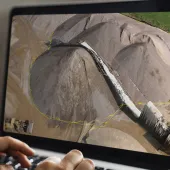Analysis of Shallow Slope Failure

First published in the March 2017 issue of Quarry Management
Maptek I-Site Studio software contributes to workflow for analysing slope failure in weathered rock at a quarry in New Zealand
In May 2016, TAGA Engineering Software Ltd flew an unmanned aerial vehicle (UAV) over part of Winstone Aggregates’ Belmont Quarry in the Lower Hutt province of New Zealand to record detailed photographs of localized bench failures.
The aim was to develop a workflow starting with drone photography and concluding with back analysis of the slope failure using their 3D slope analysis program, TSLOPE.
A subset of the large number of UAV images was processed using Pix4D software to generate an ortho-mosaic photograph. A cloud of 1,033,537 points with xyz and rgb values was also generated by Pix4D and loaded into TSLOPE for visualization.
Slope failure
The quarry produces aggregate for the construction industry from a greywacke deposit comprising highly indurated quartzofeldspathic sandstone with interbedded siltstone. The rock in the upper levels is variably weathered.
The shallow slope failure occurred on an upper-level bench slope and measured about 14m high and 20m wide at the toe.
Slope failures are controlled by rock structure. Intersecting rock fractures form the failure surface exposed towards the top part of the slope face. The failure surface is then assumed to continue towards the toe of the slope, where it is covered by debris.
Surface modelling
TAGA needed models of the original topographic surface and the failure surface to back calculate in-situ strengths that applied at the time of the failure.
Since TSLOPE cannot produce surfaces from point clouds, TAGA used specialized Maptek I-Site Studio tools. The raw UAV data was loaded into I-Site Studio and viewed in 3D (see fig. 1).
I-Site can distinguish vegetation and remove selected points from the scene. A user-defined panel indicates a filter direction and a search size parameter to define the underlying ground.
I-Site was then used to construct the two surfaces needed for import into TSLOPE. First, the pre-failure topography was built by removing points involved with the slope failure and constructing a continuous surface across the remaining points.
Further data manipulation allowed modelling of the failure surface, with an assumption that the base of the shear surface intersected the toe of the slope. Figure 2 compares pre and post-slide topography.
The original topography modelled using I-Site Studio was loaded into TSLOPE as the top surface, and the shear failure as the basal surface.
Greywacke material properties were entered, with unit weight (unsaturated) of 20kN/m3, and Mohr Coulomb parameters – cohesion of 4kPa and angle of friction of 30°. These estimated numbers reflect the low stresses acting on the failure surface. A three-dimensional slope case was then defined, with an assumption that no groundwater pressures applied.
The slope case discretizes the model into vertical columns overlying the basal surface, in this case 100 columns across the width (see figs 3&4). The darker colour shows the active columns involved in the slope stability calculations.
TSLOPE then provided a solution using Spencer’s method, with a calculated factor of safety of 1.16 (fig. 5). This suggests that the strengths used in the model are a little higher than would have applied at the time of failure.
To understand the range of strengths that would apply at a factor of safety of 1.0, a back analysis of the slope failure was carried out using different combinations of Mohr Coulomb parameters. The cross plot in figure 6 shows the range of strengths corresponding to different factors of safety.
To further understand shallow slope failures, similar systematic studies are recommended. By aggregating the cross plots, it will be possible to show the range of strengths that should apply to weathered greywacke at shallow depth below ground surface.
ACKNOWLEDGEMENT
Permission to reproduce this article from the September 2016 edition of Maptek’s Forge Newsletter is gratefully acknowledged. Thanks are also due to Ian Brown of TAGA Engineering Software Ltd and Geoff Cooke of Belmont Quarry.
- Subscribe to Quarry Management, the monthly journal for the mineral products industry, to read articles before they appear on Agg-Net.com








